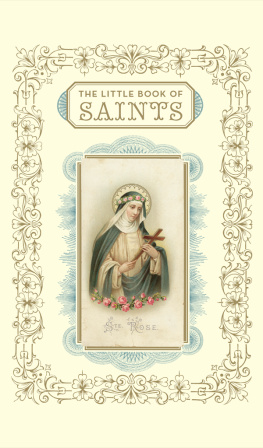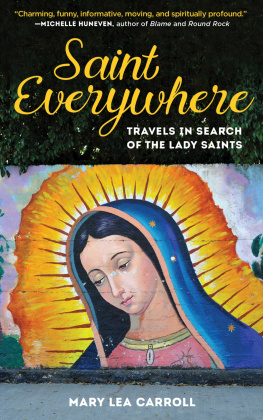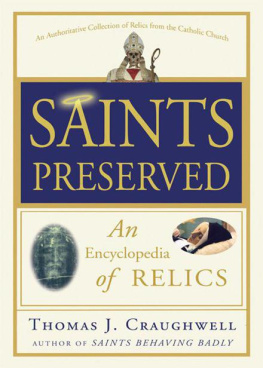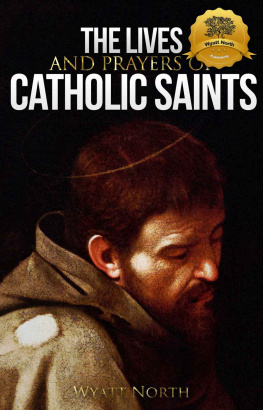Thanks to all who aided me in researching and writing this book. I am grateful to the librarians of many institutions that served me well, especially the Winter Park Public Library for many interlibrary loans and the Hesburgh Library of the University of Notre Dame, my alma mater.
This book would not have been possible without the generosity of my friend and saint-watcher Don Fishel, who allowed me to root through and borrow many of his thousands of books by and about saints.
I am indebted to my friend and agent Joseph Durepos, whose vision, coaching, and encouragement made this a much better book. Thanks, too, to Evelyn Bence, my friend and an author in her own right, who with her characteristic thoroughness and persistence obtained the copyright permissions for this book. And I am grateful to the entire editorial team at Doubleday, who insisted on excellence and purged many of my errors. But any remaining mistakes are all mine.
How to Use This Book
You may read Voices of the Saints in a variety of ways:
1) You may systematically read one selection each day through the year. To help you keep track, Voices of the Saints is numbered from 1 to 365.
2) The saints are arranged in alphabetical order. So you can dip in anywhere to find a saint that interests you.
3) If you would like to get a sense of the flow of church history, you may read the selections in historical time order. Begin with Mary and follow the Go to command. Mary will lead you to Joseph, Joseph to Joachim and Anne, or back to Mary. Or start with any saint in any time period you choose and follow the Go to and Go back to commands that accompany each article.
4) You may also read Voices of the Saints by topic. Just choose a subject from the chart of ninety-six themes and go to the saints listed for each topic. You will find subjects of perennial interest such as Angels, Conversations with God, and Miracles Do Happen. And you may be intrigued by these topics: Avant-Garde Saints, Married Saints, Porcupine Saints, and Twenty-Something Saints. The themes.
5) By using the Calendar of Saints, you may read this book chronologically through the year from January through December. Note that while the calendar is based on the liturgical year of Roman Rite of the Catholic Church, only saints presented in Voices of the Saints are listed. A Calendar of Saints.
Voices of the Saints is cross-referenced. When the name of a saint who is treated in the book appears within a selection, I have printed it in semibold type. Thus, for example, when St. Bernard of Clair-vaux appears thus in the article on St. Malachy, it indicates that you may also find interesting and related information in the article about St. Bernard.
The saints feast day, canonization information, and patronage appear at the end of each daily reading.
Introduction
If they, why not I?If these men and women could become saints, why cannot I with the help of him who is all-powerful?
ST. AUGUSTINE
Saints intrigue us. We recognize something special about them that seems to set them apart. They have achieved an excellence that we admire, but that we suppose we can never reach. Virtue is our Everest, said saint-watcher Phyllis McGinley,and those who climb highest are most worth admiring. So we honor the saints by mentally placing them on pedestals that distance them from us, believing them to be the exceptional and we the ordinary.
When we get to know the saints a little better, however, that imagined distance shrinks. Observing saints more closely reveals that they were ordinary people just like us. I am inspired by seeing St. Teresa of Avila scarfing down a partridge instead of fasting and St. Lutgarde interrupting her Eucharistic devotion to get a snack. I like noting the inconsistency of St. Sabas, who punished a disciple for looking at a beautiful woman that he also had apparently eyed with appreciation. I am relieved to discover that St. Bertilla, with whom I share not only a name but a persistent problem with anger, once had to repent for cursing a young nun who crossed her. Even saints who lived with Christ and personally experienced his heavenly invasion stayed earthbound. Only a week after Christs rising, for example, St. Peter got bored and said, Im going fishing, and six other saints tagged along (Jn 21:3).
What distinguishes saints from most people is their life purpose. Simply put, more than anything else, they wanted to be saints. May God keep us in his grace, wrote fifteen-year-old Dominic Savio to a friend, and help us to become saints. Young Thrse of Lisieux resolved to become a saint. She said, I am determined to find an elevator to carry me to Jesus, for I was too small to climb the steep stairs of perfection It is your arms, Jesus, which are the elevator to carry me to heaven. And Ignatius of Loyola stated his intention in words that invite our imitation: The saints were of the same frame as I. Why should I not do as they have done? This compelling desire for sanctity motivated all the saints, and their resolve invited a divine touch.
But determination does not create saints. As the word saint indicates, only God makes saints. Saint comes from a Latin root that means holy or reserved for God. The presence of the divine in human beings causes them to be holy and transforms them into saints. In fact, Scripture calls all Christians saints because God dwells in us. We share with those we call saints a union with God that makes us more like them than we may realize. Grace gives us all the potential to become saints like Teresa, Ignatius, Thrse, and Dominic Savio. If we dont aim for it, we lose out. The one sadness, said Lon Blois, is not to be a saint.
Of the millions of saints who have preceded us, the church has formally identified some women and men to aid us on our journey. Over the centuries and throughout the world, it has in diverse ways recognized about ten thousand saints. The early church first recognized martyrs as saintsmen and women who died for their faith. Christians began to remember the dates of the martyrs deaths as their birthday into heaven, visit their tombs to ask for their intercession, write their stories, and enroll their names on lists called martyrologies. About the fourth century, when the persecutions subsided, the church started to recognize women and men who had not been martyred, but who would have given their lives for Christ had they had the chance. For the next six centuries, holy virgins, monks, lay theologians, widows, priests, and bishops had their names added to the lists of saints everywhere.
Today we call the churchs way of making saints canonization. The term literally refers to adding a name to a canon, or an official list of saints. But the term has come to refer more broadly to the process used to verify a persons reputation for holiness. Today only the pope proclaims a saint after the Congregation for the Causes of Saints, the churchs official saint-making research group, completes a lengthy and rigorous examination of the persons life.













